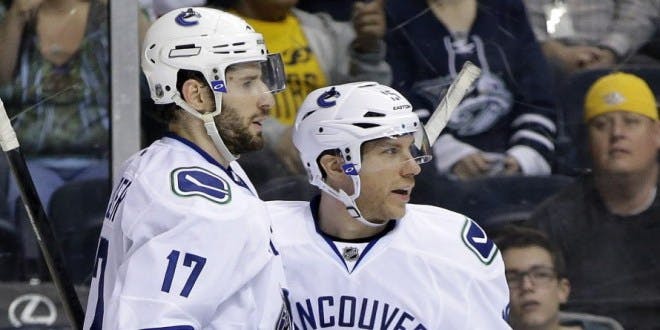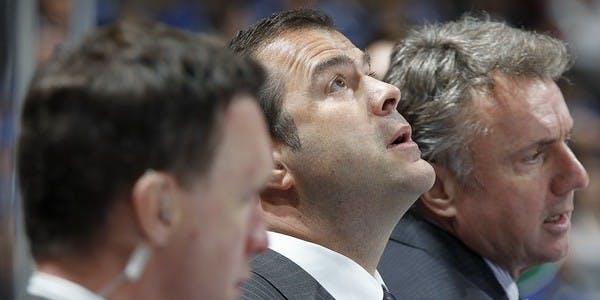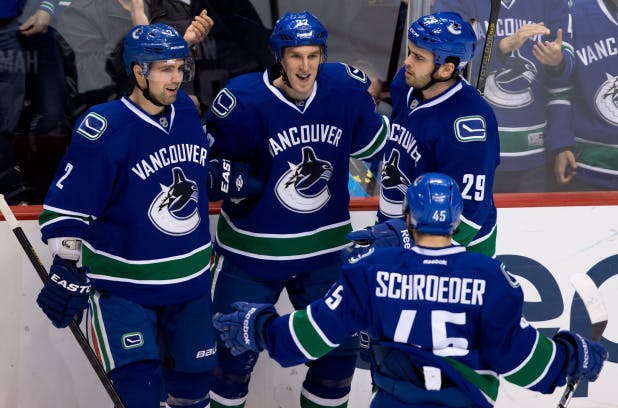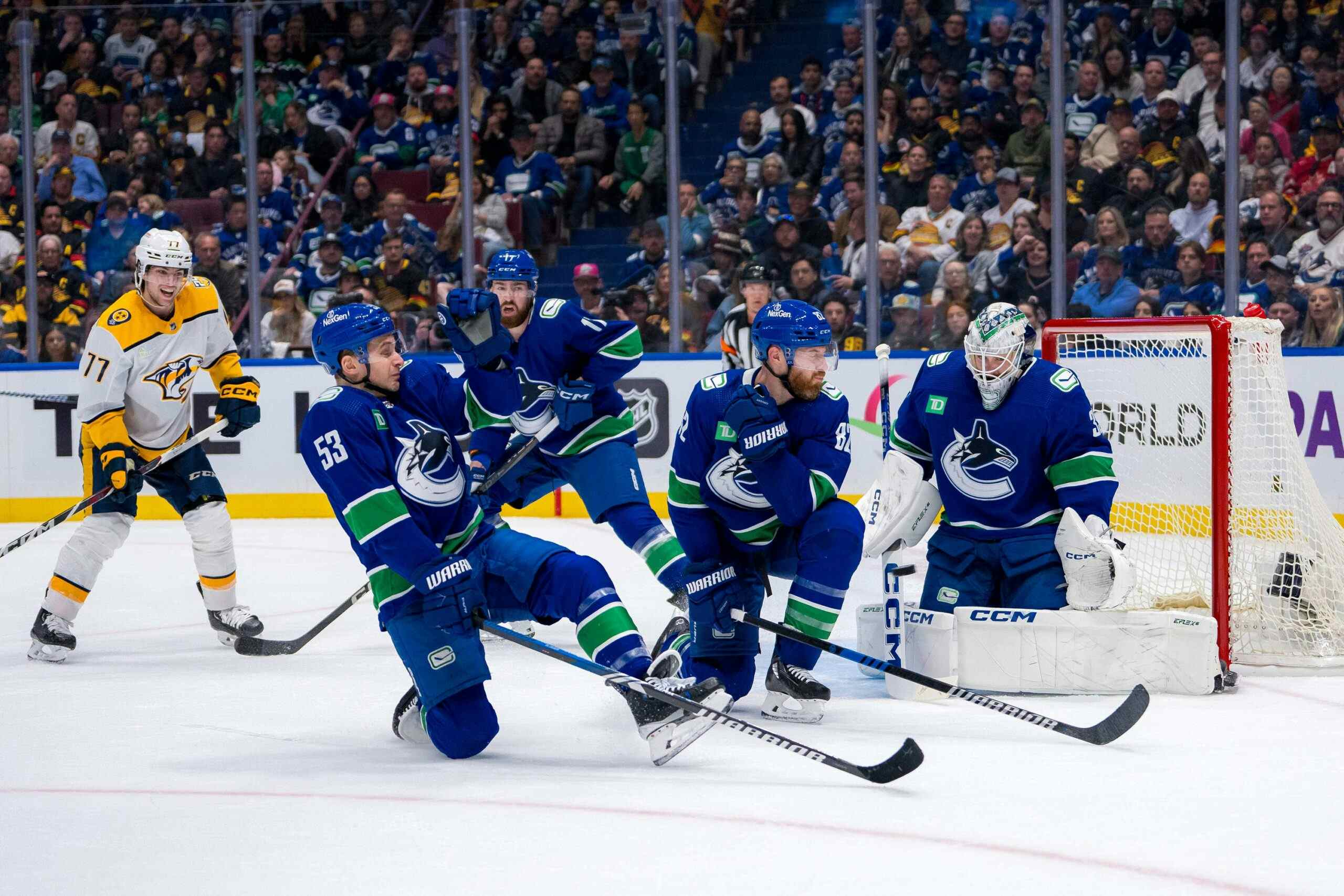Three Tough Tactical Choices Facing the Canucks Ahead of the Playoffs
Heading into the postseason, the Canucks have some pretty weighty tactical choices to make. Some of the questions facing the club include: do you keep Ryan Kesler and Derek Roy together? How do you deploy a quality fourth-line when you only employ ten quality NHL players? Do you prioritize defence and count on your goaltending, or should this club push the tempo? We look at those three questions in detail after the jump.
Load up two scoring lines or fatten up the top-nine?

AP PHOTO/MARK HUMPHREY
This has to be Vancouver’s biggest conundrum heading into the postseason. For much of the year the Canucks were a one-line team that completely relied on the Sedin twins to carry them, while the rest of the lineup got badly outshot in a desperate effort to hold the fort. Since the acquisition of Derek Roy at the trade deadline and the return of Ryan Kesler from injury, the team has vacilated between playing Ryan Kesler and Derek Roy on a "loaded" second-line, and playing them separately which helps lend the team a "fatter" top-nine group. So what’s the right approach?
The issues here are manifold, and depending on what the Canucks choose to do, it will reverberate throughout the lineup. For example, the Canucks don’t have a lot of depth on the wings, frankly, and Ryan Kesler hasn’t seemed able to drive play singlehandedly this season (like he’s been able to do in the past).
For example, though admittedly Kesler’s underlying data is polluted because of small sample size and the fact that he played six and a half games on a broken foot this season, the only regular linemate whom Kesler has been in the black by the possession data while skating alongside this year, is Derek Roy. Perhaps a few weeks from now that’ll change. At the moment, however, I wouldn’t bet on Ryan Kesler coming out ahead against tough matchups while also carrying around, say, Mason Raymond and Zack Kassian like a couple of backpacks.
So the risk you run in separating Ryan Kesler and Derek Roy, as I see it, is that you’re back to being a one-line team. The risk you run if you play Roy and Kesler together, is that the bottom end of your lineup will get crushed by the opposition. So, yeah, this qualifies a tough tactical choice.
On Thursday night with the Canucks down a couple of goals, Alain Vigneault separated the Ryan Kesler, Chris Higgins, Derek Roy line and played Ryan Kesler with Alex Burrows and Mason Raymond in the third period. This makes a bit more sense since Alex Burrows is a damn good two-way player, and the sort of guy Kesler is going to need on his wing if he’s going to be successful in the first round, I think.
Of course, when the Canucks bump Alex Burrows down the lineup, they incur something of an opportunity cost since Burrows’ presence on the top-line has a synergistic impact on the production and puck possession game of the Sedin twins. So in other words, if the Canucks deploy their top-nine forward group in a "fatter" fashion, then splitting up the twins and Alex Burrows might be the cost of doing business. Is that really warranted based on how the twins have performed with other regular line-mates this season, namely Zack Kassian and Jannik Hansen?
We’ll turn to a with or without you (WOWY) table which includes goals for, goals against, Corsi Events for and against (rated per sixty minutes) Corsi event differential (also rated per sixty minutes) and Corsi for expressed as a percentage. These are pretty small samples we’re playing with, but I just wanted to get an idea of how much better the twins have played with Burrows on their line than they’ve played without him:
| 2012-13 | TOI | GF | GA | CF/60 | CA/60 | CD/60 | CF% |
|---|---|---|---|---|---|---|---|
| Henrik with Burrows | 444: 49 | 27 | 10 | 62.58 | 38.31 | 24.27 | 62% |
| Henrik with Hansen | 56: 19 | 2 | 1 | 78.84 | 42.63 | 36.21 | 64.9% |
| Henrik with Kassian | 122: 02 | 6 | 3 | 60.48 | 40.32 | 20.16 | 60% |
Stats in this table courtesy of stats.hockeyanalysis.com
It looks like Burrows’s impact on the twins has been pretty substantial this season (as it has been over a much larger sample in the past). Burrows with the twins has served to make Vancouver’s top-line a stingier defensive group, and a much more efficient goal producing group too.
On the other hand, the twins are still reasonably productive and totally dominate possession when they skate with Jannik Hansen or Zack Kassian as well, and it’s certainly possible that this particular opportunity cost is worthwhile if Alex Burrows and Ryan Kesler can give you a secondary scoring group that can also win matchups against one of the opposition’s top-two lines.
I don’t know what the right answer is here, frankly. To some extent I think it might depend on the situation and the matchup (you can probably get away with loading up the second line against a team like Minnesota or even Chicago if Bolland is hurt, but you should probably have Derek Roy on the third-line against a deeper forward group like the Blues, Sharks or Kings). Utilizing this Canucks forward group the right way looks to be a tall task for Vancouver’s coaching staff headed into the postseason, and I’ll be very curious to see what choices they make.
Fourth Line Problems
If we’re being frank, I don’t know that it’s clear that the Canucks have twelve NHL caliber forwards who will also be available to play hockey in the first round. By my count the Canucks have ten surefire NHL quality forwards they can count on (The Sedin twins, Burrows, Kesler, Raymond, Higgins, Roy, Hansen, Lapierre) and three wild cards in Zack Kassian, Jordan Schroeder and Dale Weise. Beyond that I’d probably qualify Steve Pinizzotto, Andrew Ebbett and Tom Sestito as below replacement level, guys who really shouldn’t be in the lineup unless the team gets ravaged by injuries.
So yeah it’s quite possible, likely even, that Vancouver’s fourth-line won’t even be as good as it was during the 2010-11 Stanley Cup run. That’s a low bar too, considering the team’s fourth line that season included Victor Oreskovich.
A year ago both the Devils and the Los Angeles Kings had servicable fourth lines, lines you could count on to play eight minutes in a meaningful contest without hurting you. Over the course of an extended playoff run – hell even over the course of a hard fought seven game series – that can make a significant difference. The Canucks just don’t have that personnel to deploy a fourth line of that quality, which means the coaching staff is going to have to get creative when filling in the bottom-end of the team’s roster.
One option is playing Keith Ballard as a forward. On Thursday against a depleted Ducks team, the Canucks used a fourth-line that primarily consisted of Andrew Ebbett, Zack Kassian and Keith Ballard, and that group was completely torched. That’s concerning but we should mention that Keith Ballard came out ahead in two previous games as a forward this season. Also, considering Vancouver’s fourth-line isn’t likely to see many minutes in the postseason anyway, you might as well have a guy like Ballard in that slot since he can provide you with some injury insurance should a defenceman get hurt in any given contest.
Another option might be to play Maxim Lapierre on the third-line as a winger with Derek Roy and Chris Higgins. That line could soak up defensive zone-starts and would have two capable faceoff winners too (one right-handed, one left-handed). With Jannik Hansen bumping up to play with, say, Kesler and Burrows and Kassian taking regular shifts with the Sedin twins, you could potentially ice a speed fourth line of Dale Weise, Jordan Schroeder and Mason Raymond (not like Raymond belong in the top-six after the month he’s had anyway).
Sure that line won’t crash and bang like a prototypical "energy line", but is it a group that can play eight minutes in a meaningful contest without hurting you? I tend to think it might be. The downside with that is that Maxim Lapierre isn’t all that well suited to a permanent top-nine role.
In short, until David Booth returns from injury (and who knows when, or even if that’ll happen), there just aren’t any really good options for the Canucks when it comes to their fourth line.
Collapsing or "Blowing the Zone"?
The Canucks might be taking this "deep defensive zone coverage" thing a bit too far.
Photograph by Jonathan Hayward, the Canadian Press
I wrote the other day about how ridiculously good the Sedin twins have been defensively this season. On Friday in his must read Thirty Thoughts weekly, CBC’s Elliott Friedman got some player quotes which help us flesh out the subject. The most interesting nugget Friedman reported, however, was about a tactical change Canucks coaches have made this season:
The second change the coaching staff made was asking forwards to play deeper in the defensive end than before. At their attacking best, the Canucks were known for "blowing the zone," allowing forwards to break for offensive opportunities before the puck was cleared.That doesn’t happen as often. In an effort to defend some of the bigger lines and teams, the Canucks cover the points less in an effort to swarm the opposition down low. That’s improved defensive-zone coverage, but makes it harder to score.
Mike Gillis has talked often this season about the way NHL defensive systems are collapsing to block the net, portraying these types of ssytems as patient zero in how the league has changed tactically and become more defence oriented. At the same time, the Canucks have adjusted with it, obviously, and by prioritizing a deeper-type defensive formation in lieu of "blowing the zone" and generating offensive opportunities, the team seems to have installed a more conservative game plan overall. It has worked for the club this season, but is it playing to the team’s strengths?
I’m not really sure. I generally don’t think it makes a lot of sense to play into a type of gameplan that probably suits clubs like St. Louis and Los Angeles somewhat better than it suits the Canucks. For what it’s worth Vancouver’s overall conservatism shows up in the underlying data, as the club has been a very average possession club once they’ve got even a one goal lead at even-strength this season. On the other hand, when the Canucks are down a goal and pushing the pace their fastball still compares favourably with the top teams in the National Hockey League.
It’s commendable that the Sedin twins have stepped up their two-way play this season. There’s no doubt that it makes the team better. But the Canucks need to play to their strengths, and with Ryan Kesler, Derek Roy and the Sedin twins in the fold along with four capable and productive offensive defenceman in the top-four (Edler, Hamhuis, Bieksa, Garrison), I find it somewhat difficult to wrap my head around the notion that this club is optimally built to grind out victories in mucky, low-scoring playoff games…
Recent articles from Thomas Drance







